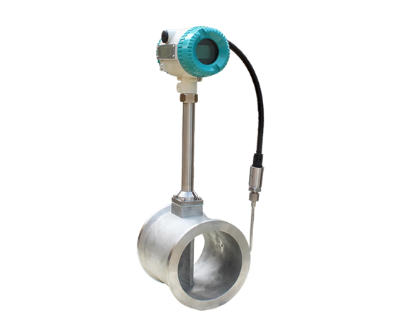How to adjust the coefficient of steam flow meter?
2024-06-14
The adjustment coefficient of steam flow meter is to make it more accurately reflect the actual steam flow change. The following are the steps of adjusting the coefficient of the steam flowmeter, summarized in a clear and fractional way:
Preparation work:
Ensure that the main pipe, by-pass pipe, and the pressure and temperature holes, joints, flanges, and valves on them are properly installed, screwed, and welds are in good condition.
Check whether the sensor of the steam flow meter is installed correctly, including the installation direction and installation method.
Check that the electrical connection is correct and the grounding is good.
Static debugging:
Slowly open the upstream valve, close the downstream valve, let the fluid flow into the measuring pipe, the pressure in the pipe rises to the working pressure, and ensure that there is no leakage in the connection.
Turn on the power supply, check whether the rating and ripple of the measuring power supply are normal, and observe the static operation of the steam flow meter and various supporting instruments.
In the case of static operation, ensure that the steam flowmeter has no output signal, the analog output signal should be 4mA, and the output end of the pulse signal should have no output square wave; The instantaneous flow indicator is zero, and the cumulative flow rate should not change.
Dynamic debugging:
Check the flow through, close the bypass valve, slowly open the downstream valve, so that the flow rate is stable and slowly increased, and observe whether the pulse signal frequency of the output of the steam flowmeter is steadily increased, and whether the flow indication is proportional to the increase of the flow rate.
Adjustment factor:
After the steam flowmeter enters a stable working state, it is debugged according to multiple preset flow points. At each flow point, the upstream and downstream throttling devices of the meter are adjusted so that the meter reading reaches the expected value.
For example, a 1% adjustment increases the reading by 1%. Repeat this process until all predetermined flow points have been tested.
Calculate new coefficients and update:
The new coefficient values are calculated according to the measured results and the original parameters.
In the flow meter setting interface (such as the parameter setting interface entered through the password), find the flow coefficient menu, enter the new coefficient value according to the operation instructions, and save the Settings.
Note:
During the adjustment process, the working environment of the flowmeter should be ensured to avoid external interference.
After adjusting the coefficient, the flow test should be performed again to ensure that the flow meter can accurately reflect the actual flow rate.
If you want to know more about the flow meter or flow meter selection, please consult the Aister flow meter manufacturer email: sales@aistermeter.com for help.
Ensure that the main pipe, by-pass pipe, and the pressure and temperature holes, joints, flanges, and valves on them are properly installed, screwed, and welds are in good condition.
Check whether the sensor of the steam flow meter is installed correctly, including the installation direction and installation method.
Check that the electrical connection is correct and the grounding is good.
Static debugging:
Slowly open the upstream valve, close the downstream valve, let the fluid flow into the measuring pipe, the pressure in the pipe rises to the working pressure, and ensure that there is no leakage in the connection.
Turn on the power supply, check whether the rating and ripple of the measuring power supply are normal, and observe the static operation of the steam flow meter and various supporting instruments.
In the case of static operation, ensure that the steam flowmeter has no output signal, the analog output signal should be 4mA, and the output end of the pulse signal should have no output square wave; The instantaneous flow indicator is zero, and the cumulative flow rate should not change.
Dynamic debugging:
Check the flow through, close the bypass valve, slowly open the downstream valve, so that the flow rate is stable and slowly increased, and observe whether the pulse signal frequency of the output of the steam flowmeter is steadily increased, and whether the flow indication is proportional to the increase of the flow rate.
Adjustment factor:
After the steam flowmeter enters a stable working state, it is debugged according to multiple preset flow points. At each flow point, the upstream and downstream throttling devices of the meter are adjusted so that the meter reading reaches the expected value.
For example, a 1% adjustment increases the reading by 1%. Repeat this process until all predetermined flow points have been tested.
Calculate new coefficients and update:
The new coefficient values are calculated according to the measured results and the original parameters.
In the flow meter setting interface (such as the parameter setting interface entered through the password), find the flow coefficient menu, enter the new coefficient value according to the operation instructions, and save the Settings.
Note:
During the adjustment process, the working environment of the flowmeter should be ensured to avoid external interference.
After adjusting the coefficient, the flow test should be performed again to ensure that the flow meter can accurately reflect the actual flow rate.
If you want to know more about the flow meter or flow meter selection, please consult the Aister flow meter manufacturer email: sales@aistermeter.com for help.
Share To:
Previous Post:
Next Post:
News
- Why is the thermal gas mass flowmeter not affected by pressure strength and temperature?
- What to do when a thermal gas mass flow meter fails?
- How are thermal gas mass flow meters used? What are the applications?
- Under what circumstances is the gas measurement need to be regulated compensated vortex flowmeter
- Why Is The Aister Thermal Gas Mass Flowmeter So Popular ?
- Gas turbine flowmeter manufacturers explain their main advantages in measurement
- Gas turbine flowmeter manufacturer Aister instrument field experience summary
- Aister Instrument Empowerment Conference









